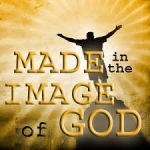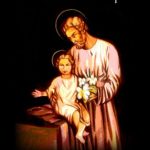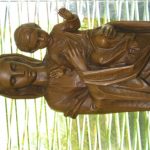 William McNamara, OCD wrote: “To be unique is not a matter of peculiar differences but of outstanding fidelity . . . fidelity to myself and the God who calls me to become more and more gracefully myself, my very best self, not in isolation but in communion with the whole human race.” McNamara adds that we must continue until we are “so faithful that God will look on me with pleasure and say: ‘This is my beloved son.’” What a beautiful way to think of uniqueness! Enneagrams, Myers-Briggs tests, fingerprints, and just plain living can prove our unique qualities; however, to think in terms of deepening fidelity puts us in direct line with the moment of our creation and our faithfulness to that moment.
William McNamara, OCD wrote: “To be unique is not a matter of peculiar differences but of outstanding fidelity . . . fidelity to myself and the God who calls me to become more and more gracefully myself, my very best self, not in isolation but in communion with the whole human race.” McNamara adds that we must continue until we are “so faithful that God will look on me with pleasure and say: ‘This is my beloved son.’” What a beautiful way to think of uniqueness! Enneagrams, Myers-Briggs tests, fingerprints, and just plain living can prove our unique qualities; however, to think in terms of deepening fidelity puts us in direct line with the moment of our creation and our faithfulness to that moment.
 January 9 is the birthday of our foundress Sister Maria Aloysia Wolbring. The birthday of our co-foundress Sister Maria Ignatia is the following day. Their charism that began the Sisters of Notre Dame in 1850 is one of trust in God’s provident love and goodness
January 9 is the birthday of our foundress Sister Maria Aloysia Wolbring. The birthday of our co-foundress Sister Maria Ignatia is the following day. Their charism that began the Sisters of Notre Dame in 1850 is one of trust in God’s provident love and goodness
Consecrated religious life is in a time of transition for many reasons: decreased number of sisters and brothers, aging members, the placing of institutions in the hands of the laity. Accompanying these reasons and more importantly are the needs of the world and our response to those needs.
Historically, religious communities have filled the needs of the times primarily in schools and hospitals. Now is the time to consider new opportunities that fit our charism. New ventures will definitely call us to trust God’s providence. As all of us take a contemplative look at the future, we share our thoughts. As I wish Sister Maria Aloysia “Happy birthday” I share one of mine.
Sister Maria Aloysia, along with Sister Maria Ignatia, did the next thing that needed to be done. Orphans needing a home? Sister Maria Aloysia provided a home. A teacher needed in another town? Sister Maria Aloysia filled the position. Elderly persons not being cared for? Sister Maria Aloysia brought some elderly individuals into the convent. What is the next thing that needs to be done? While the future has not come into full focus, we Sisters are ready and eager, trusting in God’s provident love and goodness.
Popular yard signs and hash tags tell us that Black Lives Matter, Women Matter, You Matter. I’ve never seen a yard sign “God-matter.” Yet the outdoor Christmas decorations that are starting to disappear are signs of “God-matter.” The Logos, the Word of God, took on a body. God and matter united, and in that process all matter is spiritualized. God became Jesus of Nazareth, the Christogenesis that makes God the heart of all matter, the Christogenesis by which human energy is integrated with divine energy throughout the cosmos.
Soon stable scenes will disappear, the Holy Family statues wrapped and stored. Perhaps we will not reflect on the pregnant Mary until Advent 2019. Meanwhile we have twelve months to reflect on the world, a divine milieu pregnant with God (Chardin).
Magi on the Move
Among my favorite Christmas cards to give and receive are those with the Magi. The silhouettes of camels and riders crossing the desert in the twilight stirs me to join the trek. “Come on! Come let us adore!” the pictures call. This year I received a Magi card from a charitable organization, and its message was perfect: “Called to see the face of Christ in ‘the least of these,’ you responded with amazing love and generosity.” How “least” must have Mary, Joseph, and the Child seemed to these learned seers whose wealth could bring gold, frankincense, and myrrh. Wiser for this visit and richer in soul, the three departed by another way—warned in a dream and invited by the Child to follow the Way.
 Edith Stein wrote: “A new year at the hand of the Lord—we do not know whether we shall experience the end of this year. . . . The Divine Child offers us his hand to renew our [commitment]. Let us hurry to clasp this hand.” Is Edith Stein’s thought yours as we begin a new year? Although I wonder what the year will hold, I rarely wonder whether I will be alive at its end. But perhaps I should. The year stretches ahead, and my calendar is already marked with major events, some that may hold a huge impact on my religious community and my parish.
Edith Stein wrote: “A new year at the hand of the Lord—we do not know whether we shall experience the end of this year. . . . The Divine Child offers us his hand to renew our [commitment]. Let us hurry to clasp this hand.” Is Edith Stein’s thought yours as we begin a new year? Although I wonder what the year will hold, I rarely wonder whether I will be alive at its end. But perhaps I should. The year stretches ahead, and my calendar is already marked with major events, some that may hold a huge impact on my religious community and my parish.
The future can be daunting, but my incipient fears are allayed as I look at the manger scene. The expressions on Mary’s and Joseph’s faces mix wonder and fear. Looking at the scene, I remember the Biblical reasons why Joseph and Mary rightfully felt afraid. Mary and Joseph seem to whisper to each other, “The Lord bless you and keep you! The Lord look upon you kindly and give you peace.” Looking down at the Infant, they see the One whom the Angel named Jesus and Son of the Most High. His little hand is raised in blessing to renew my commitment. I clasp his fragile fingers. He is my Peace.
 Whenever we are open to the future, the present is rich in possibilities. Does our openness to the future give us hope for a new year, a new decade, or a new century of unity and peace?
Whenever we are open to the future, the present is rich in possibilities. Does our openness to the future give us hope for a new year, a new decade, or a new century of unity and peace?
We know that in the process of evolution new entities rise up as old elements become more complex and converge. Evolution is a holy thing directed toward the future fullness of life. How? God is the core of evolution, and God is “the unstoppable urge of cosmic reality for more life.” And so we sing “And wonders of his love, and wonders of his love. . .”
 Almost 14 billion years ago God knew what God would give the world as a Christmas present. God’s creative genius began fashioning the universe. (God was the first to make Christmas presents and fill them with love.) In his infinite loving plan, the incarnation of Christ became one seamless process of God’s self-giving and communication in love with creation. In this grandiose plan the completion of creation will be the fullness of God: “When, finally, all has been subjected to the Son, he will then subject himself to the One who made all things subject to him, so that God may be all in all” (1 Cor. 15:28). At the end of the ages Jesus will give back the gift now complete and whole, “the fullness of Christ [that is] the creative diversity of all that exists held together by the Spirit of luminous love.” (The Emergent Christ, Ilia Delio)
Almost 14 billion years ago God knew what God would give the world as a Christmas present. God’s creative genius began fashioning the universe. (God was the first to make Christmas presents and fill them with love.) In his infinite loving plan, the incarnation of Christ became one seamless process of God’s self-giving and communication in love with creation. In this grandiose plan the completion of creation will be the fullness of God: “When, finally, all has been subjected to the Son, he will then subject himself to the One who made all things subject to him, so that God may be all in all” (1 Cor. 15:28). At the end of the ages Jesus will give back the gift now complete and whole, “the fullness of Christ [that is] the creative diversity of all that exists held together by the Spirit of luminous love.” (The Emergent Christ, Ilia Delio)
 We sing Christmas carols, attend midnight Mass, and exchange gifts, because Mary gave birth to Jesus. Because of her, God Almighty appeared on earth—and Christ will come again in all his glory when we participate in birthing the Christ. How do we do this? The universe is heading toward its fulfillment when it will become the fullness of Christ. We are part of the progression. Every time we grow in love, reach out in service, and in any other way make the world a better place, we are part of the evolution toward the Omega Point. We are part of the web forming Christ in his fullness. We are letting the God in us increase his dynamism within us and around us. What a privilege! So let our “praises sing to God the king, and peace to all on earth.”
We sing Christmas carols, attend midnight Mass, and exchange gifts, because Mary gave birth to Jesus. Because of her, God Almighty appeared on earth—and Christ will come again in all his glory when we participate in birthing the Christ. How do we do this? The universe is heading toward its fulfillment when it will become the fullness of Christ. We are part of the progression. Every time we grow in love, reach out in service, and in any other way make the world a better place, we are part of the evolution toward the Omega Point. We are part of the web forming Christ in his fullness. We are letting the God in us increase his dynamism within us and around us. What a privilege! So let our “praises sing to God the king, and peace to all on earth.”
 The letter to the Hebrews claims “a body you have prepared for me.” Billions of years ago God prepared a body for his Son by creating a universe. Then in the fullness of time God’s power in material things came to a climax in the Incarnation of Jesus. On that first Christmas night the goodness, truth, and beauty of the universe reside in a tiny Baby and move toward fulfillment in the glorified Christ. When Mary and Joseph looked upon the Little One, God with a baby smell, they were surrounded by animals, feeding trough, straw and hay. Christmas carols bemoan the fact that Jesus wasn’t born in a palace. Yet looking back two millennia, we begin to realize that everything in the universe (straw, hay, animals, mother and foster father) are all modeled on Christ, for He is the reason and goal of all creation. The tiny sounds from a baby Boy, the Word of God, were moving through the universe, giving it meaning and reaching to its fulfillment. The currents running through the Baby’s blood are the same current that runs through the swirling galaxies. Christ did much more than come to save us from our sins. Christ is the very reason for the world. The whole universe is incarnational, for Jesus the Christ makes all things holy. Come not only to the stable, but also to your dinner table and Christmas tree for all creation is sacred because God became human and invested himself in our universe. “Come adore on bended knee Christ the Lord, the newborn King!”
The letter to the Hebrews claims “a body you have prepared for me.” Billions of years ago God prepared a body for his Son by creating a universe. Then in the fullness of time God’s power in material things came to a climax in the Incarnation of Jesus. On that first Christmas night the goodness, truth, and beauty of the universe reside in a tiny Baby and move toward fulfillment in the glorified Christ. When Mary and Joseph looked upon the Little One, God with a baby smell, they were surrounded by animals, feeding trough, straw and hay. Christmas carols bemoan the fact that Jesus wasn’t born in a palace. Yet looking back two millennia, we begin to realize that everything in the universe (straw, hay, animals, mother and foster father) are all modeled on Christ, for He is the reason and goal of all creation. The tiny sounds from a baby Boy, the Word of God, were moving through the universe, giving it meaning and reaching to its fulfillment. The currents running through the Baby’s blood are the same current that runs through the swirling galaxies. Christ did much more than come to save us from our sins. Christ is the very reason for the world. The whole universe is incarnational, for Jesus the Christ makes all things holy. Come not only to the stable, but also to your dinner table and Christmas tree for all creation is sacred because God became human and invested himself in our universe. “Come adore on bended knee Christ the Lord, the newborn King!”
There are two parts to Advent, the final part beginning on December 17 and ending on Christmas. On these days the antiphon for the Magnificat in Evening Prayer addresses Christ with the seven Messianic titles. Sometimes this second part of Advent is called the “Golden Nights.”
The O Antiphons have been around since the fourth century. The monks had a custom of enjoying certain treats on each day. For example, on the day of Root of Jesse, they would have some kind of treat made from a root. O Rising Sun was the day to serve oranges. On the Key of David day the monk in charge of the wine cellar used the key to the wine cellar to serve fine wine.
The O Antiphons are lined up chronologically with the oldest Messianic title first. They are Sapientia (Wisdom), Adonai (Leader), Radix (Root), Clavis (Key), Oriens (East or Dawn), Rex (King), and Emmanuel (God-with-us). We start with Wisdom, the Holy Spirit, who was there are the creation of the world. Then we dramatically climb through history until the birth of Christ in approximately 4-7 B.C.
When you line up the titles backwards, the first letter spells Ero cras, which means “Tomorrow I will come.”
Let Advent be the time for O–O-O- and Christmas for Ho-Ho-Ho!


